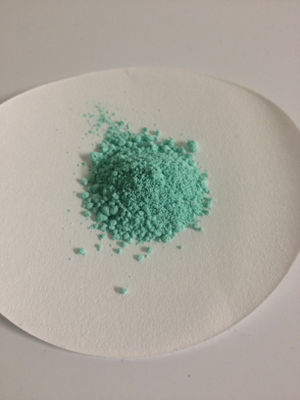Difference between revisions of "Copper oxychloride"
(→Handling) |
|||
| Line 115: | Line 115: | ||
===Physical=== | ===Physical=== | ||
| − | Cooper oxychloride is a greenish solid. | + | Cooper oxychloride is a greenish solid, odorless, insoluble in water. |
== Synthesis == | == Synthesis == | ||
Revision as of 22:16, 16 July 2018

| |
| Names | |
|---|---|
| IUPAC name
Cu2(OH)3Cl
| |
| Other names
Copper trihydroxyl chloride
Micronutrients TBCC Intellibond C Copper Hydroxychloride Tribasic copper chloride (TBCC) | |
| Properties | |
| Cu2(OH)3Cl | |
| Molar mass | 213.56 g/mol |
| Appearance | Pale turquoise or green solid |
| Odor | Odorless |
| Density | 3.5 g/cm3 |
| Melting point | 250 °C (482 °F; 523 K) |
| Boiling point | Decomposes |
| Insoluble | |
| Solubility | Insoluble in organic solvents |
| Hazards | |
| Safety data sheet | Sigma-Aldrich |
| Flash point | Non-flammable |
| Related compounds | |
| Related compounds
|
Copper(II) chloride Copper(II) oxide |
| Except where otherwise noted, data are given for materials in their standard state (at 25 °C [77 °F], 100 kPa). | |
| Infobox references | |
Copper oxychloride is the common name given to the compound with formula Cu2(OH)3Cl, more correctly referred to as dicopper chloride trihydroxide, or sometimes basic copper chloride. It exists in several forms with different appearances that can be prepared by different routes, but all are the same compound. Copper oxychloride finds real-world applications as a fungicide and also as a blue or green coloring agent in pyrotechnics, while also being used in niche applications as a catalyst for various reactions, such as the production of vinyl chloride.
Contents
Properties
Chemical
Copper oxychloride will react with a base to precipitate copper hydroxide.
Physical
Cooper oxychloride is a greenish solid, odorless, insoluble in water.
Synthesis
The synthesis of dicopper chloride trihydroxide has been described in literature through many means. One method useful in a home chemistry setting is by the slow and careful addition of an excess of a dilute solution of sodium bicarbonate, ammonia, or sodium hydroxide to an acidic solution of copper(II) chloride without stirring; this is important as stirring may result in the dissolution of the product in the surrounding acidic medium and subsequent loss of the hydroxide ions. A second pathway involves the oxygenation of a non-acidic solution of copper(I) chloride and sodium chloride.
Uses
Depending on the polymorph of copper oxychloride used, and therefore the method of synthesis, the product may find use as a pigment or colorant for ceramics or other materials. Provided that sodium and/or potassium contaminants are removed from the end product to the proper degree, dicopper chloride trihydroxide yields a deep blue-to-green flame color, which can be advantageous to those creating colored pyrotechnic displays.
One potential method for the bulk production of copper(I) oxide involves the addition of a suspension of copper oxycloride in sodium bicarbonate solution to an acidic solution containing a reducing sugar, followed by prolonged heating in a similar manner to Fehlig's test for reducing sugars.
Finally, tribasic copper chloride has found use as a catalyst for many organic syntheses and also as a reagent used in the production of other catalysts. Reactions that make use of this property often center around oxidations or chlorinations of organic molecules, in particular the chlorination of ethylene.
Handling
Safety
Copper compounds are harmful if ingested.
Storage
Should be kept in clean plastic or glass bottles.
Disposal
Copper oxychloride can be dissolved in an acid and reduced to copper metal.